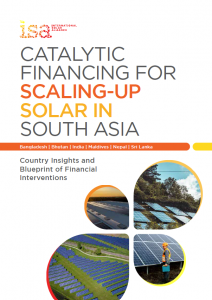Catalytic Financing for Scaling Up Solar in South Asia

Multiple countries in South Asia have made ambitious net zero targets to address climate change, including Bangladesh’s proposal for 2050 and India’s commitment for 2070. This calls for
accelerating the clean and renewable energy transition. The region has immense renewable energy prospects, especially for solar energy which holds a potential of 939 GW.1 However, only 3.8% of the total potential has been developed so far.
The Catalytic Financing Facility for solar aims to infuse investments in the emerging solar segments across target countries. The proposed facility is designed to take a co-investment or blended approach, combining patient development capital with commercial capital to reduce the overall cost of capital while de-risking investments. The facility will de-risk incoming capital with a combination of risk mitigation mechanisms such as payment guarantees, partial credit guarantees and others, while building the ecosystem through capacity development of stakeholders. The concessional capital will assume a high-risk position while commercial capital will be in a low-risk position enabled by grants that provide risk mitigation
measures. The capital flowing through the capacity is expected to largely provide debt to the enterprises and projects while equity, grants, and technical assistance will receive the rest of the share.
Key benefits of the facility are seen across two primary pillars – reducing the cost of capital for project deployment which will lead to reduced tariff of solar energy to consumers;
and reduced risk profile through payment guarantee mechanisms and increased agility in the ecosystem with technical assistance. Further, the design of the facility seeks to address specific barriers in focus segments through a combination of commercial capital along with risk mitigation measures to enable commercial viability of the focus segments.




